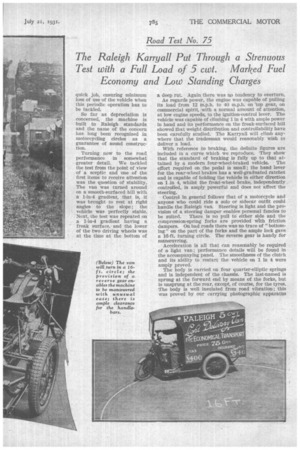The Raleigh Karryall Put Through a Strenuous Test with a
Page 51

If you've noticed an error in this article please click here to report it so we can fix it.
Full Load of 5 cwt. Marked Fuel Economy and Low Standing Charges
quick job, ensuring minimum loss of use of the vehicle when this periodic operation has to be tackled.
So far as depreciation is concerned, the machine is built to Raleigh standards and the name of the concern has long been recognized in motorcycling circles as a guarantee of sound construction.
Turning now to the road performance in somewhat • greater detail. We tackled the test from the point of view • of a sceptic and one of the • first Reins to receive attention • was the question of stability. The van was turned around • on a smooth-surfaced hill with a 1-in-4 gradient, that is, it was brought to rest at right angles to the slope ; the vehicle was perfectly stable. 'Next, the test was repeated on a 1-in-4 gradient having a freak surface, and the lower • of the two driving wheels was at the time at the bottom of a deep rut. Again there was no tendency to overturn.
As regards power, the engine was capable of pulling its load from 12 m.p.h. to 40 m.p.h. on -top gear, on commercial spirit, with a normal amount of attention, at low engine speeds, to the ignition-control lever. The vehicle was capable of climbing 1 in 4 with ample power in hand and its performance on the freak-surfaced hill showed that weight distribution and controllability have been carefully studied. The Karryall will climb anywhere that the tradesman would reasonably wish to deliver a load.
With reference to braking, the definite figures are included in a curve which we reproduce. They show that the standard of braking is fully up to that attained by a modern four-wheel-braked vehicle. The effort required on the pedal is small ; the hand lever for the rear-wheel brakes has a wen-graduated ratchet and is capable of holding the vehicle in either direction on 1 in 4, whilst the front-wheel brake, independently _ controlled, is amply powerful and does not affect the steering.
Control in general follows that of a motorcycle and anyone who could ride a solo or sidecar outfit could handle the Raleigh van. Steering is light and the provision of a steering damper enables personal fancies to be suited_ There is no pull td either side and the compression-spring forks are provided with friction dampers. On bad roads there was no trace of ' bottoming " on the part of the forks and the ample lock gave 16-ft. turning circle. The reverse gear is handy for manceuvring.
Acceleration is all that can reasonably be required of a light van; performance details will be found in the accompanying panel. The smoothness of the clutch and its ability to restart the vehicle on 1 in 4 were amply proved.
The body is carried on four quarter-elliptic springs and is independent of the chassis. The last-named is sprung at the forward end by means of the forks, but is unsprung at the rear, except, of course, for the tyres. The body is well insulated from road vibration ; this was proved by our carrying photographic apparatus




































































































